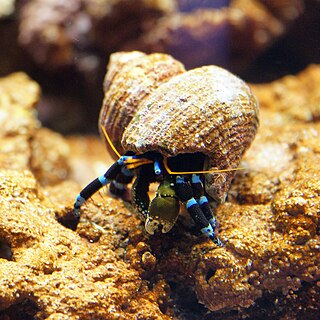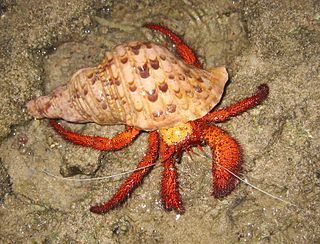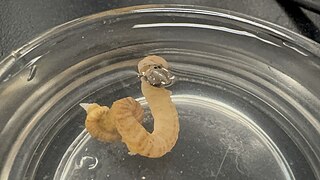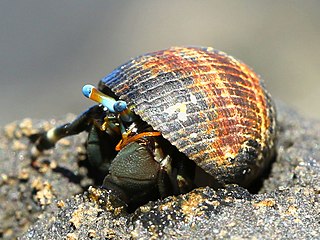
Hermit crabs are anomuran decapod crustaceans of the superfamily Paguroidea that have adapted to occupy empty scavenged mollusc shells to protect their fragile exoskeletons. There are over 800 species of hermit crab, most of which possess an asymmetric abdomen concealed by a snug-fitting shell. Hermit crabs' soft (non-calcified) abdominal exoskeleton means they must occupy shelter produced by other organisms or risk being defenseless.

The halloween hermit crab, also known as the striped hermit crab or orange-legged hermit crab, is a brightly colored aquatic hermit crab of the family Diogenidae. Besides its ability to routinely clean algae in aquaria, the halloween hermit crab's festive striped coloration also appeals to enthusiasts; it is considered the most brightly colored hermit crab in normal aquarium use.

Coenobita perlatus is a species of terrestrial hermit crab. It is known as the strawberry hermit crab because of its reddish-orange colours. It is a widespread scavenger across the Indo-Pacific, and wild-caught specimens are traded to hobby aquarists.

Paguristes cadenati, the red reef hermit crab or scarlet hermit crab, is a small species of hermit crab with a bright red body and yellow eyestalks that lives in the Caribbean Sea. The specific name honours the French ichthyologist Jean Cadenat (1908-1992), who collected the type specimen and sent it to the French carcinologist Jacques Forest, who described it as a new species.
Algae eater or algivore is a common name for any bottom-dwelling or filter-feeding aquatic animal species that specialize in feeding on algae and phytoplanktons. Algae eaters are important for the fishkeeping hobby and many are commonly kept by aquarium hobbyists to improve water quality. They are also important primary consumers that relay the biomass and energy from photosynthetic autotrophes up into the food web, as well as protecting the aquatic ecosystem against algae blooms.

Clibanarius tricolor is a hermit crab that lives in shallow water of the Caribbean Sea and is popular in the home aquarium trade. Its common names include blue-legged hermit crab, tricolor hermit crab, blueleg reef hermit crab, equal handed hermit crab and blueleg hermit crab.

Calcinus elegans, also known as the blue line hermit crab, is a small, tropical hermit crab.

Dardanus pedunculatus, commonly referred to as the anemone hermit crab, is a species of hermit crab from the Indo-Pacific region. It lives at depths of up to 27 m and collects sea anemones to place on its shell for defence.

Dardanus megistos, the white-spotted hermit crab or spotted hermit crab, is a species of hermit crab belonging to the family Diogenidae.

Cerithium litteratum is a species of sea snail, a marine gastropod mollusk in the family Cerithiidae.

Vermicularia knorrii, commonly known as the Florida worm snail, is a species of sea snail, a marine gastropod in the family Turritellidae. V. knorrii has been concluded to be the junior synonym to Vermicularia lumbricalis. The shell of Florida worm snail is light brown or tan in color with an apex that is white. It is found living in reefs on the coasts of the southern states of the United States to the top of South America. V. knorri use their ciliated appendages to trap plankton and sperm.
Calcinus tubularis is a species of hermit crab. It is found in the Mediterranean Sea and around islands in the Atlantic Ocean, where it lives below the intertidal zone. Its carapace, eyestalks and claws are marked with numerous red spots. C. tubularis and its sister species, C. verrilli, are the only hermit crabs known to show sexual dimorphism in shell choice, with males using normal marine gastropod shells, while females use shells of gastropods in the family Vermetidae, which are attached to rocks or other hard substrates.

Trapezia rufopunctata is a species of guard crabs in the family Trapeziidae.
Calcinus verrillii, commonly known as Verrill's hermit crab, is a species of hermit crab in the genus Calcinus which is endemic to Bermuda. It was first described by the American zoologist Mary J. Rathbun and named in honour of the American zoologist Addison Emery Verrill, who spent much time with his students studying the geology and marine fauna of Bermuda.

Calcinus laevimanus is a species of hermit crab in the genus Calcinus found in the Indo-West Pacific region, the type locality being Hawaii. It is also known as the blue-eyed hermit crab, zebra hermit crab, dwarf zebra hermit crab, left-handed hermit crab, Hawaiian reef hermit and other similar names.

Calcinus morgani, commonly known as Morgan's hermit crab, is a species of hermit crab in the family Diogenidae found in the Indo-West Pacific region, the type locality being Indonesia.

Heterocyathus is a genus of coral of the family Caryophylliidae.

Calcinus seurati, commonly known as Seurat's hermit crab or whitebanded hermit, is a species of hermit crab in the family Diogenidae. It was first described by French carcinologist Jacques Forest in 1951.

Paguristes puncticeps is a hermit crab, in the family Diogenidae. It is found in shallow waters in the tropical western Atlantic Ocean, the Caribbean Sea and the Gulf of Mexico. Like other hermit crabs, it lives inside an empty mollusc shell, which it changes periodically as it grows.
Calcinus argus, also known as the Argus hermit crab, is a species of hermit crabs in the family Calcinidae described by David Wooster in 1984. Originating from the Indo-West Pacific near Hawaii.

















